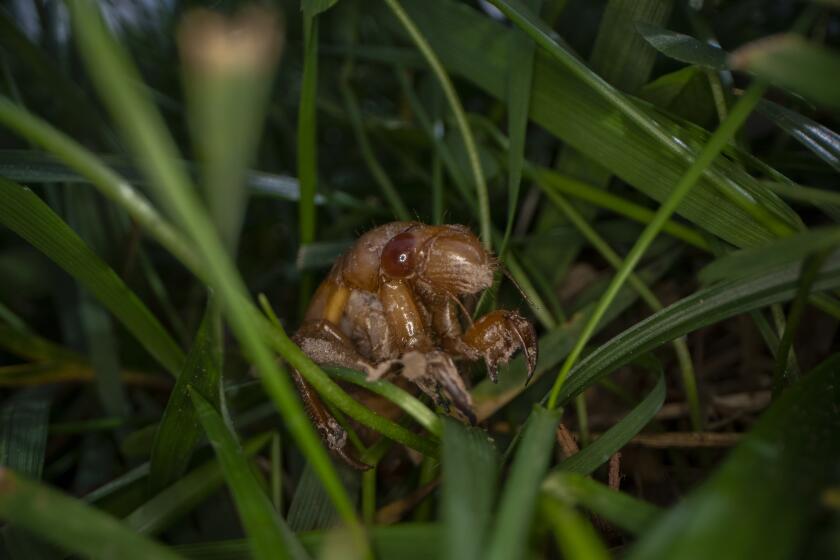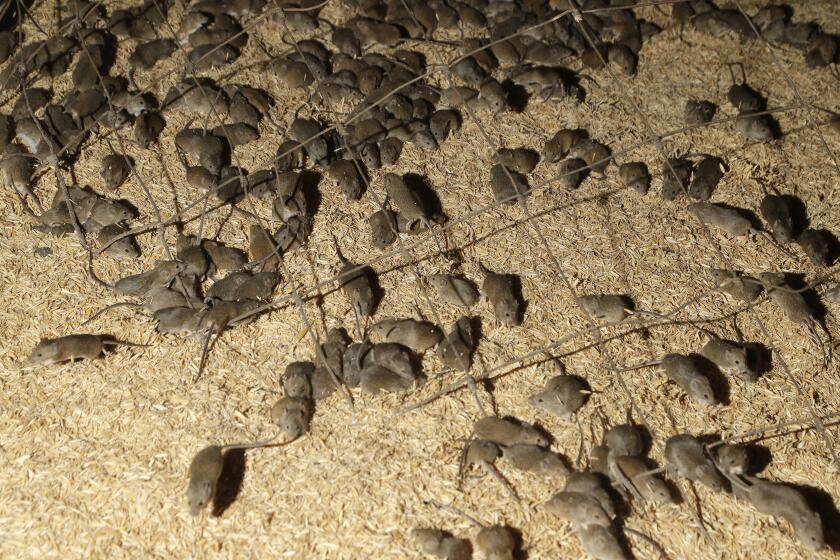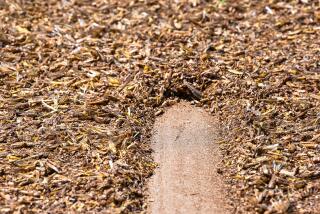Forget cicadas. Drought-stricken West is getting plagued by voracious grasshoppers

- Share via
BILLINGS, Mont. — A punishing drought in the U.S. West is drying up waterways, sparking wildfires and leaving farmers scrambling for water. Next up: a plague of voracious grasshoppers.
Federal agriculture officials are launching what could become their largest grasshopper-killing campaign since the 1980s amid an explosion of the drought-loving insects, which cattle ranchers fear will strip bare public and private rangelands.
In central Montana’s Phillips County, more than 50 miles from the nearest town, Frank Wiederrick said large numbers of grasshoppers started showing up on prairie surrounding his ranch in recent days. Already they’re beginning to denude trees around his house.
“They’re everywhere,” Wiederrick said. “Drought and grasshoppers go together, and they are cleaning us out.”
Grasshoppers thrive in warm, dry weather, and populations already were up last year, setting the stage for an even bigger outbreak in 2021. Such outbreaks could become more common as climate change shifts rainfall patterns, scientists said.
To blunt the grasshoppers’ economic damage, the U.S. Department of Agriculture this week began aerial spraying of the pesticide diflubenzuron to kill grasshopper nymphs before they develop into adults. About 3,000 square miles in Montana are expected to be sprayed, roughly twice the size of Rhode Island.
After spending the last 17 years underground, the noisy insects are ready to surface. ‘This is a feel-good story, folks,’ one scientist insists.
Agriculture officials saw this year’s infestation coming after a 2020 survey found dense concentrations of adult grasshoppers across about 55,000 square miles of the West. A 2021 grasshopper “hazard map” shows densities of at least 15 insects per square yard in large areas of Montana, Wyoming and Oregon and portions of Idaho, Arizona, Colorado and Nebraska.
Left unaddressed, the grasshoppers could cause agricultural damage so severe that beef and crop prices would go up, federal officials said.
The pest-control program’s scale has alarmed environmentalists who say widespread spraying will kill numerous other insects, including struggling species such as monarch butterflies, and also spiders and other grasshopper predators. They’re also concerned that the pesticides could ruin organic farms adjacent to spray zones.
“We’re talking about natural areas being sprayed. This is not cropland,” said Sharon Selvaggio, a former U.S. Fish and Wildlife Service biologist now with the Xerces Society, a conservation group focused on insects.
Vast tracts of land in Australia’s New South Wales state are being threatened by a mouse plague that officials say is ‘absolutely unprecedented.’
Government officials say they will spray pesticides in low concentrations and reduce the area treated by spraying alternate strips of rangeland. The intent is to kill grasshoppers passing between strips while sparing other insects that don’t move as far.
If spraying is delayed and grasshoppers grow larger and more resilient, federal officials could resort to two more toxic pesticides: carbaryl and malathion, according to government documents.
Selvaggio said pesticides could drift into areas not being targeted and kill beneficial insects such as bees that pollinate crops. “The toxicity is more than enough to kill bees,” she said. “This is not adequate protection.”
Organic farmers are divided on spraying. Some are concerned about losing their organic certification for years if they inadvertently get pesticides on their crops, while others are willing to tolerate spraying out of deference to their neighbors’ problems, said Jamie Ryan Lockman, director of Organic Montana.
Toward a more sustainable California
Get Boiling Point, our newsletter exploring climate change, energy and the environment, and become part of the conversation — and the solution.
You may occasionally receive promotional content from the Los Angeles Times.
The trade group isn’t going to challenge the spraying but wants organic farmers protected and for the government to research alternatives to chemicals for future outbreaks.
As this year’s brood of grasshoppers emerges, they’re starting to compete with cattle for food in arid eastern Montana, where single ranches can sprawl over thousands of acres of private and public rangeland.
The grasshoppers start eating tender plants first, then move on to full-grown plants and the seed heads of grain crops, killing them, said Marko Manoukian, a Montana State University agriculture extension agent in Phillips County. Farmers can collect insurance on damaged crops, whereas ranchers have no recourse when the grasshoppers remove vegetation from public lands.
“They are competing against our food supplies,” said Manoukian.
Billions of locusts have swarmed over at least eight East African countries, consuming crops so rapidly that experts fear widespread famine.
A typical infestation can remove 20% of forage from the range and have a $900-million impact, according to a 2012 University of Wyoming study cited by federal officials.
At his ranch, not far from the Charles M. Russell National Wildlife Refuge, Wiederrick is preparing to sell up to 70% of his cows this summer because he fears they won’t have enough feed.
The federal government’s grasshopper program dates to the 1930s, when infestations covered millions of acres in 17 western states. After local efforts failed, Congress put the agriculture department in charge of controlling the insects on federal rangeland.
The last outbreak on a scale comparable to this year lasted from 1986 to 1988. Almost 20 million acres were treated with 1.3 million gallons of malathion, according to researchers.
Diamond Valley Lake, an “inland ocean,” is Southern California’s prime defense against drought.
The grasshoppers targeted include roughly a dozen of the hundreds of native species in the West. Drought benefits them in part because it lessens exposure of grasshopper eggs to deadly parasites that need moisture, said Chelse Prather, a University of Dayton insect ecologist.
This year’s outbreak will peak in roughly two months, when the insects reach two to three inches in length and become so prevalent they’ll start to eat more plant matter than cattle can, Prather said.
The grasshoppers start to die down when there’s nothing left to eat, Prather said, “but at that point they’ve probably already ... laid their eggs for next year.”
More to Read
Sign up for Essential California
The most important California stories and recommendations in your inbox every morning.
You may occasionally receive promotional content from the Los Angeles Times.














